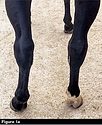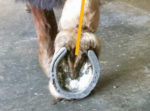Advertise Follow Us
Items Tagged with 'Lamesness'
ARTICLES
Don’t Let The Hinds Become An Afterthought
English farrier explains how he assesses a horse behind for conformation and balance
Read More
Research Journal: December 2017
The information, ideas and opinions expressed are those of the author and do not necessarily represent those of the United States Department of Agriculture.
Read More
Research Journal: April 2017
The information, ideas and opinions expressed are those of the author and do not necessarily represent those of the United States Department of Agriculture.
Read More
Proactive Footcare For Limiting Hind Limb Lameness
Farrier Grant Moon finds that thorough evaluation and emphasis of the trim will improve likelihood for success for managing feet
Read More
Research Journal: March 2017
The information, ideas and opinions expressed are those of the author and do not necessarily represent those of the United States Department of Agriculture.
Read More
Reprinted with permission from Equine Veterinary Education (EVE). Original published in Equine Veterinary Education Vol 28 June 2016.
Various Aspects Of Barefoot Methodology Relevant To Farriery
This thorough review will help you analyze and plan for transitioning a horse from shod to barefoot
Read More








